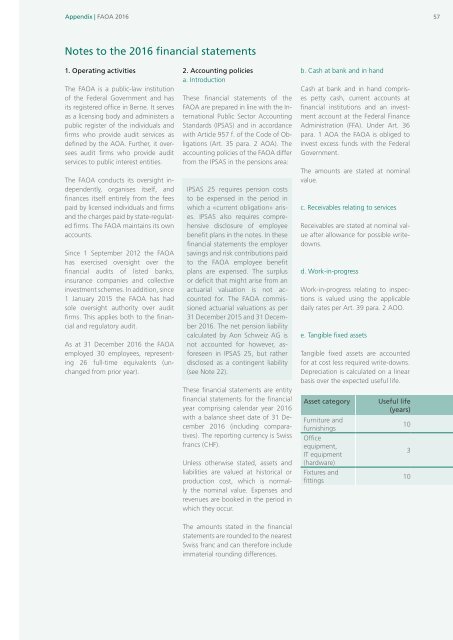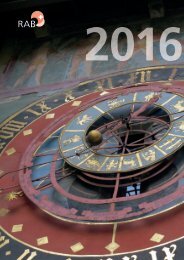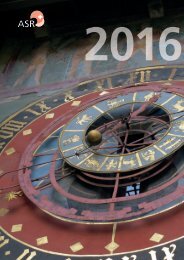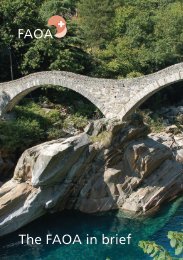Annual Report 2016
Annual Report 2016 - Federal Audit Oversight Authority FAOA
Annual Report 2016 - Federal Audit Oversight Authority FAOA
- No tags were found...
Create successful ePaper yourself
Turn your PDF publications into a flip-book with our unique Google optimized e-Paper software.
Appendix | FAOA <strong>2016</strong><br />
57<br />
Notes to the <strong>2016</strong> financial statements<br />
1. Operating activities<br />
The FAOA is a public-law institution<br />
of the Federal Government and has<br />
its registered office in Berne. It serves<br />
as a licensing body and administers a<br />
public register of the individuals and<br />
firms who provide audit services as<br />
defined by the AOA. Further, it oversees<br />
audit firms who provide audit<br />
services to public interest entities.<br />
The FAOA conducts its oversight independently,<br />
organises itself, and<br />
finances itself entirely from the fees<br />
paid by licensed individuals and firms<br />
and the charges paid by state-regulated<br />
firms. The FAOA maintains its own<br />
accounts.<br />
Since 1 September 2012 the FAOA<br />
has exercised oversight over the<br />
financial audits of listed banks,<br />
insurance companies and collective<br />
investment schemes. In addition, since<br />
1 January 2015 the FAOA has had<br />
sole oversight authority over audit<br />
firms. This applies both to the financial<br />
and regulatory audit.<br />
As at 31 December <strong>2016</strong> the FAOA<br />
employed 30 employees, representing<br />
26 full-time equivalents (unchanged<br />
from prior year).<br />
2. Accounting policies<br />
a. Introduction<br />
These financial statements of the<br />
FAOA are prepared in line with the International<br />
Public Sector Accounting<br />
Standards (IPSAS) and in accordance<br />
with Article 957 f. of the Code of Obligations<br />
(Art. 35 para. 2 AOA). The<br />
accounting policies of the FAOA differ<br />
from the IPSAS in the pensions area:<br />
IPSAS 25 requires pension costs<br />
to be expensed in the period in<br />
which a «current obligation» arises.<br />
IPSAS also requires comprehensive<br />
disclosure of employee<br />
benefit plans in the notes. In these<br />
financial statements the employer<br />
savings and risk contributions paid<br />
to the FAOA employee benefit<br />
plans are expensed. The surplus<br />
or deficit that might arise from an<br />
actuarial valuation is not accounted<br />
for. The FAOA commissioned<br />
actuarial valuations as per<br />
31 December 2015 and 31 December<br />
<strong>2016</strong>. The net pension liability<br />
calculated by Aon Schweiz AG is<br />
not accounted for however, asforeseen<br />
in IPSAS 25, but rather<br />
disclosed as a contingent liability<br />
(see Note 22).<br />
These financial statements are entity<br />
financial statements for the financial<br />
year comprising calendar year <strong>2016</strong><br />
with a balance sheet date of 31 December<br />
<strong>2016</strong> (including comparatives).<br />
The reporting currency is Swiss<br />
francs (CHF).<br />
Unless otherwise stated, assets and<br />
liabilities are valued at historical or<br />
production cost, which is normally<br />
the nominal value. Expenses and<br />
revenues are booked in the period in<br />
which they occur.<br />
b. Cash at bank and in hand<br />
Cash at bank and in hand comprises<br />
petty cash, current accounts at<br />
financial institutions and an investment<br />
account at the Federal Finance<br />
Administration (FFA). Under Art. 36<br />
para. 1 AOA the FAOA is obliged to<br />
invest excess funds with the Federal<br />
Government.<br />
The amounts are stated at nominal<br />
value.<br />
c. Receivables relating to services<br />
Receivables are stated at nominal value<br />
after allowance for possible writedowns.<br />
d. Work-in-progress<br />
Work-in-progress relating to inspections<br />
is valued using the applicable<br />
daily rates per Art. 39 para. 2 AOO.<br />
e. Tangible fixed assets<br />
Tangible fixed assets are accounted<br />
for at cost less required write-downs.<br />
Depreciation is calculated on a linear<br />
basis over the expected useful life.<br />
Asset category<br />
Furniture and<br />
furnishings<br />
Office<br />
equipment,<br />
IT equipment<br />
(hardware)<br />
Fixtures and<br />
fittings<br />
Useful life<br />
(years)<br />
10<br />
3<br />
10<br />
The amounts stated in the financial<br />
statements are rounded to the nearest<br />
Swiss franc and can therefore include<br />
immaterial rounding differences.
















